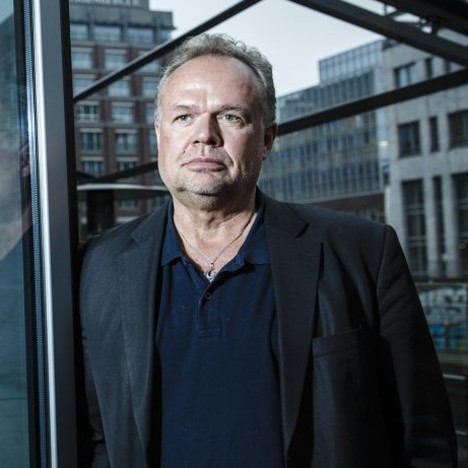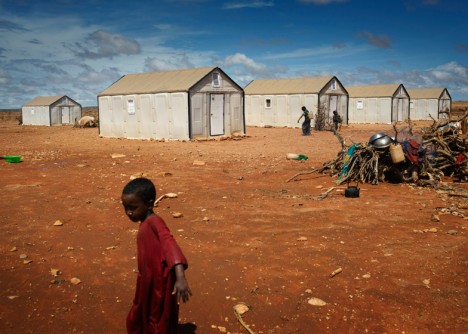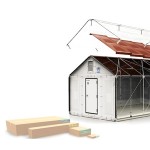 |
| Kazuto Yamaki, CEO of Sigma Corporation, pictured at CP+ 2017, with Sigma’s new 14mm F1.8. |
Sigma released four lenses at this year’s CP+ show in Yokohama – the 14mm F1.8 DG HSM Art, 24-70mm F2.8 DG OS HSM Art, 135mm F1.8 DG HSM Art and 100-400mm F5-6.3 DG OS HSM. We’re at the show, where we made time to sit down with Kazuto Yamaki, CEO of Sigma, to find our more about the new lenses.
You’ve told me previously that you really want Sigma to make more wideangle lenses. Do you think you’re achieving that goal with the 12-24mm and new 14mm?
Yes, but I’m still not satisfied. I think we need to make more wide-angle lenses. A fast 14mm was one of the lenses that our customers were asking for. Most existing 14mm lenses are F2.8, so F1.8 was a challenge.
 |
| The new Sigma 14mm F1.8 is the fastest lens of its kind, and according to Sigma, should outperform competitive, slower designs from other manufacturers. |
What have you learned, from making the Art series?
We’ve learned that some customers require exceptional lens performance. We believe that our mission is to make products that other manufacturers don’t have. If we just released similarly-specified lenses to existing models, we wouldn’t be contributing to the industry, or benefiting customers. So our Art series is meant to provide the best performance.
They’re bulky and heavy, it’s true, but our customers like them because of the performance. That’s what we learned.
Hands-on with Sigma MC-11 (CP+ 2016)
You now make a mount adapter for Sony E-mount, but are you planning native support for the Sony E-mount in the future?
Yes, that’s our plan. Our plan is to develop full-frame lenses for Sony E mount, and in the future we will have more E mount lenses. But it takes time. Normally it takes about two years to develop one lens, sometimes three. So even if I start the process now, the lens might come out in two years time.
Sigma’s new Art-series lenses have a degree of weather-sealing – why now?
It’s based on customer demand. Some of our customers said that rain and snow sometimes got into the lens mount, so they wanted sealing. And the other reason is that it’s becoming a trend. Other manufacturers are offering sealed mounts.
Does that make the design process more complex?
No, not really. The only seal is around the lens mount. It’s not a perfect weather-proofing like our Sports series. The 150-600mm for instance has sealing everywhere, on the focus ring and zoom ring.
Of the lenses in the Global Vision line, which were the most complex to bring to market?
Our 12-24mm zoom. Because that lenses uses a very large aspherical element, and at the time, no other company was producing an element of this kind, and there were no machines capable of producing it. So we designed a custom machine to make that element. But as a result of developing that technology, we were able to create this new 14mm F1.8.
 |
The Sigma 12-24mm ultra-wide zoom is a complex design, containing a very large aspherical (front) element. |
The Global Vision line is almost five years old. What are you most proud of?
Firstly, I’m still not satisfied. We need to do more. But these days, I’m pretty happy that people regard Sigma as a high-quality company. In the past, some people regarded Sigma as just another third-party lens manufacturer, and maybe even as a cheap, low-quality lens supplier. But people’s perception has been changing, gradually, and I’m very happy about that.
One of the things that professional Canon and Nikon photographers rely on is the support networks for service, like CPS and NPS. Is a professional service support system something that Sigma is interested in creating?
I think we’ll have to. In Japan we’ve already started a pro support project, and I hope we can create a global professional support system very soon.
In the past you’ve expressed concern that you don’t want Sigma to grow too much, too quickly, because this might threaten some the magic of being a small company. Is this something that you’re still worried about?
Growing too fast is not good. We need to grow, but we should grow gradually. We need to develop our capability to produce higher-quality products. That’s the priority. Then turnover, and sales, and profit will follow. We do not prioritize making the company bigger. We focus on product quality, and technology.
Over the past five years, we’ve actually been making fewer lenses, because we decreased the number of cheaper lenses we were producing. But we’ve expanded our manufacturing capacity, because the higher-end lenses use more glass. Cheaper lenses might use 10-15 elements, but these higher quality lenses use 15-20, sometimes even more elements. So more capacity is needed to make a single lens. We’ve actually invested massively in the past five years.
Sigma and Fujifilm have recently introduced lineups of cine lenses. How much growth do you see in this segment?
We don’t know. Even before I decided to get into the cine lens market, I tried to collect market data, but there’s no data out there. It’s not available. It’s only anecdotal. But we guessed that this segment will grow in the future.
Video has lower resolution demands than stills, but we’ve been designing lenses for 36+ megapixel sensors for several years. That is equivalent to 8K, in video terms. A lot of traditional cine lenses aren’t that high resolution. Our lenses might be more affordable, but they’re top quality.
 |
| The Sigma Cine lens range includes a geared version of the company’s 18-35mm F1.8, now known as the 18-35mm T2. The lens covers the Super 35 format and requires a roughly 350 degree rotation to zoom from 18-35mm, allowing very precise control. |
Do you have a market share target for your cine lenses?
No, we’re waiting to see how the market develops. We can dream, but it’s not the same thing!
Editors’ note:
We always enjoy speaking to Mr Yamaki, partly because on the occasions when we get the opportunity to do so, it’s usually because he’s just unveiled something really interesting. Mostly though, we enjoy speaking to Sigma’s CEO because he’s a nice guy. Open, honest, and candid about Sigma’s plans and ambitions, Mr Yamaki is well-liked in the photography industry, even by his competitors.
Speaking of competitors, I get the feeling that Mr Yamaki was compelled to deliver the new 14mm F1.8 partly out of a general disappointment with the available options for photographers. Sigma has a strong history of innovating in the wide and ultra-wide market, and the new 14mm, alongside the previously-released 12-24mm certainly look like a confident statement of intent. If the 14mm is as good as Mr Yamaki claims (and we are rarely disappointed by the optical performance of Sigma’s Art series) it looks set to be a reference lens for landscape, architectural and astrophotographers. We’re hoping to be able to post a gallery of samples very soon – watch this space.
Also interesting, is another statement of intent – Sigma’s move into affordable cine lenses. While the company is not competing (yet) with the Arris of this world, or with Canon’s Cinema EOS optics, Sigma (like Fujifilm) sees an opportunity to cater to a newer generation of videographers who are working with mirrorless systems. Optically, Sigma’s cine lenses should be top notch, although being based on existing stills lens designs, we’re told that some qualities, such as focus breathing, might cause issues for professional broadcast and film cinematographers. There is a reason, after all, that high-end professional cine lenses can cost tens of thousands of dollars.
So what next for Sigma? We wouldn’t be surprised if Mr Yamaki is working on more wideangle lenses, and following the new 24-70mm F2.8, it seems likely that the company will refresh its 70-200mm F2.8 in the near future, too. More Sony E-mount optics are also on the way, we’re told, which will be welcome news to Sony a7-series users.
Articles: Digital Photography Review (dpreview.com)






















You must be logged in to post a comment.